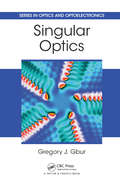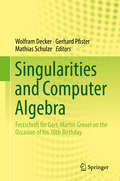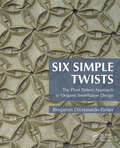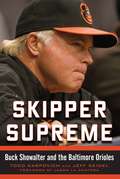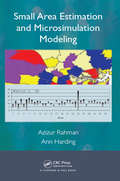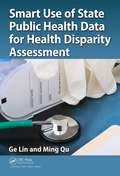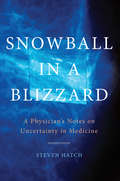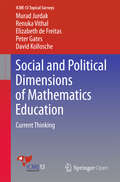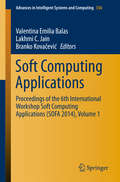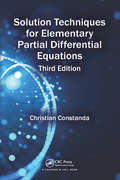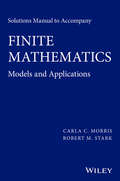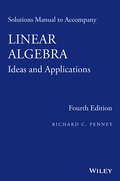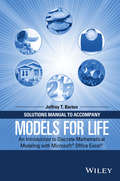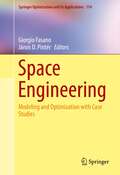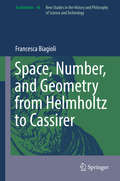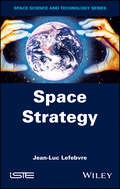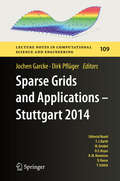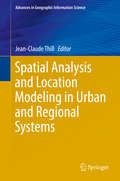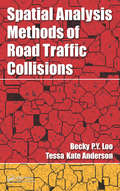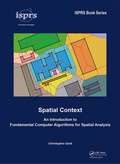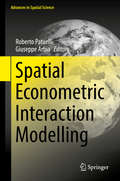- Table View
- List View
Singular Optics (Series in Optics and Optoelectronics)
by Gregory J. Gbur"This engagingly written text provides a useful pedagogical introduction to an extensive class of geometrical phenomena in the optics of polarization and phase, including simple explanations of much of the underlying mathematics." —Michael Berry, University of Bristol, UK "The author covers a vast number of topics in great detail, with a unifying mathematical treatment. It will be a useful reference for both beginners and experts…." —Enrique Galvez, Charles A. Dana Professor of Physics and Astronomy, Colgate University "a firm and comprehensive grounding both for those looking to acquaint themselves with the field and those of us that need reminding of the things we thought we knew, but hitherto did not understand: an essential point of reference." —Miles Padgett, Kelvin Chair of Natural Philosophy and Vice Principal (Research), University of Glasgow This book focuses on the various forms of wavefield singularities, including optical vortices and polarization singularities, as well as orbital angular momentum and associated applications. It highlights how an understanding of singular optics provides a completely different way to look at light. Whereas traditional optics focuses on the shape and structure of the non-zero portions of the wavefield, singular optics describes a wave’s properties from its null regions. The contents cover the three main areas of the field: the study of generic features of wavefields, determination of unusual properties of vortices and wavefields that contain singularities, and practical applications of vortices and other singularities.
Singularities and Computer Algebra
by Wolfram Decker Gerhard Pfister Mathias SchulzeThis book arose from a conference on "Singularities and Computer Algebra" which was held at the Pfalz-Akademie Lambrecht in June 2015 in honor of Gert-Martin Greuel's 70th birthday. This unique volume presents a collection of recent original research by some of the leading figures in singularity theory on a broad range of topics including topological and algebraic aspects, classification problems, deformation theory and resolution of singularities. At the same time, the articles highlight a variety of techniques, ranging from theoretical methods to practical tools from computer algebra. Greuel himself made major contributions to the development of both singularity theory and computer algebra. With Gerhard Pfister and Hans Sch#65533;nemann, he developed the computer algebra system SINGULAR, which has since become the computational tool of choice for many singularity theorists. The book addresses researchers whose work involves singularity theory and computer algebra from the PhD to expert level.
Six Simple Twists: The Pleat Pattern Approach to Origami Tessellation Design
by Benjamin DiLeonardo-ParkerGet Started with Tessellation FoldingSix Simple Twists: The Pleat Pattern Approach to Origami Tessellation Design explains the process of designing an origami pattern. It answers the questions "how is a tessellation folded" and "what are the further possibilities."The author introduces an innovative pleat pattern technique of origami design that is
Skipper Supreme: Buck Showalter and the Baltimore Orioles
by Todd Karpovich Jeff Seidel Jason La CanforaFor the first decade of the 21st century, the Baltimore Orioles were perpetual cellar dwellers, with losing seasons from 1998-2011-fourteen straight years. They were the worst team in baseball when two-time American League Manager of the Year Buck Showalter took over as manager in August 2010, but they went 34-23 in the last two months of the season, and that set the tone for everything to follow.Buck, along with Andy MacPhail (president of baseball operations) and Dan Duquette (general manager), worked hard to change things in Baltimore, and the results have shown. In 2012, the Orioles went 93-69 and reached the postseason for the first time since 1997. In 2013, they fell short of the playoffs, but they still hit the most homers in the majors. They also set a new record in errorless games and fewest errors in a season. In addition, the Orioles boasted three Gold Glove winners: third baseman Manny Machado, center fielder Adam Jones, and shortstop J.J. Hardy. In 2014, after winning the AL East, they swept the Tigers in the divisional series before losing to the red-hot Royals in the American League Championship.This book details the club’s miraculous turnaround under Buck. It discusses key signings like Nelson Cruz, the quiet effectiveness of Nick Markakis, Jones’s leadership, the struggles of Chris Davis, and several other story lines from Showalter’s tenure.Skyhorse Publishing, as well as our Sports Publishing imprint, are proud to publish a broad range of books for readers interested in sports-books about baseball, pro football, college football, pro and college basketball, hockey, or soccer, we have a book about your sport or your team.Whether you are a New York Yankees fan or hail from Red Sox nation; whether you are a die-hard Green Bay Packers or Dallas Cowboys fan; whether you root for the Kentucky Wildcats, Louisville Cardinals, UCLA Bruins, or Kansas Jayhawks; whether you route for the Boston Bruins, Toronto Maple Leafs, Montreal Canadiens, or Los Angeles Kings; we have a book for you. While not every title we publish becomes a New York Times bestseller or a national bestseller, we are committed to publishing books on subjects that are sometimes overlooked by other publishers and to authors whose work might not otherwise find a home.
Small Area Estimation and Microsimulation Modeling
by Azizur Rahman Ann HardingSmall Area Estimation and Microsimulation Modeling is the first practical handbook that comprehensively presents modern statistical SAE methods in the framework of ultramodern spatial microsimulation modeling while providing the novel approach of creating synthetic spatial microdata. Along with describing the necessary theories and their advantages and limitations, the authors illustrate the practical application of the techniques to a large number of substantive problems, including how to build up models, organize and link data, create synthetic microdata, conduct analyses, yield informative tables and graphs, and evaluate how the findings effectively support the decision making processes in government and non-government organizations. Features Covers both theoretical and applied aspects for real-world comparative research and regional statistics production Thoroughly explains how microsimulation modeling technology can be constructed using available datasets for reliable small area statistics Provides SAS codes that allow readers to utilize these latest technologies in their own work. This book is designed for advanced graduate students, academics, professionals and applied practitioners who are generally interested in small area estimation and/or microsimulation modeling and dealing with vital issues in social and behavioural sciences, applied economics and policy analysis, government and/or social statistics, health sciences, business, psychology, environmental and agriculture modeling, computational statistics and data simulation, spatial statistics, transport and urban planning, and geospatial modeling. Dr Azizur Rahman is a Senior Lecturer in Statistics and convenor of the Graduate Program in Applied Statistics at the Charles Sturt University, and an Adjunct Associate Professor of Public Health and Biostatistics at the University of Canberra. His research encompasses small area estimation, applied economics, microsimulation modeling, Bayesian inference and public health. He has more than 60 scholarly publications including two books. Dr. Rahman’s research is funded by the Australian Federal and State Governments, and he serves on a range of editorial boards including the International Journal of Microsimulation (IJM). Professor Ann Harding, AO is an Emeritus Professor of Applied Economics and Social Policy at the National Centre for Social and Economic Modelling (NATSEM) of the University of Canberra. She was the founder and inaugural Director of this world class Research Centre for more than sixteen years, and also a co-founder of the International Microsimulation Association (IMA) and served as the inaugural elected president of IMA from 2004 to 2011. She is a fellow of the Academy of the Social Sciences in Australia. She has more than 300 publications including several books in microsimulation modeling.
Smart Use of State Public Health Data for Health Disparity Assessment
by Ge Lin Ming QuHealth services are often fragmented along organizational lines with limited communication among the public health–related programs or organizations, such as mental health, social services, and public health services. This can result in disjointed decision making without necessary data and knowledge, organizational fragmentation, and disparate knowledge development across the full array of public health needs. When new questions or challenges arise that require collaboration, individual public health practitioners (e.g., surveillance specialists and epidemiologists) often do not have the time and energy to spend on them. Smart Use of State Public Health Data for Health Disparity Assessment promotes data integration to aid crosscutting program collaboration. It explains how to maximize the use of various datasets from state health departments for assessing health disparity and for disease prevention. The authors offer practical advice on state public health data use, their strengths and weaknesses, data management insight, and lessons learned. They propose a bottom-up approach for building an integrated public health data warehouse that includes localized public health data. The book is divided into three sections: Section I has seven chapters devoted to knowledge and skill preparations for recognizing disparity issues and integrating and analyzing local public health data. Section II provides a systematic surveillance effort by linking census tract poverty to other health disparity dimensions. Section III provides in-depth studies related to Sections I and II. All data used in the book have been geocoded to the census tract level, making it possible to go more local, even down to the neighborhood level.
Snowball in a Blizzard: A Physician's Notes on Uncertainty in Medicine
by Steven HatchThere's a running joke among radiologists: finding a tumor in a mammogram is akin to finding a snowball in a blizzard. A bit of medical gallows humor, this simile illustrates the difficulties of finding signals (the snowball) against a background of noise (the blizzard). Doctors are faced with similar difficulties every day when sifting through piles of data from blood tests to X-rays to endless lists of patient symptoms. Diagnoses are often just educated guesses, and prognoses less certain still. There is a significant amount of uncertainty in the daily practice of medicine, resulting in confusion and potentially deadly complications. Dr. Steven Hatch argues that instead of ignoring this uncertainty, we should embrace it. By digging deeply into a number of rancorous controversies, from breast cancer screening to blood pressure management, Hatch shows us how medicine can fail--sometimes spectacularly--when patients and doctors alike place too much faith in modern medical technology. The key to good health might lie in the ability to recognize the hype created by so many medical reports, sense when to push a physician for more testing, or resist a physician's enthusiasm when unnecessary tests or treatments are being offered. Both humbling and empowering, Snowball in a Blizzard lays bare the inescapable murkiness that permeates the theory and practice of modern medicine. Essential reading for physicians and patients alike, this book shows how, by recognizing rather than denying that uncertainty, we can all make better health decisions.
Social and Political Dimensions of Mathematics Education
by Murad Jurdak Renuka Vithal Elizabeth De Freitas Peter Gates David KolloscheThis book examines the current thinking on five critical social and political areas in mathematics education. It focuses on material conditions in teaching and learning, and details features of social life and their influence on mathematics teaching, learning and achievement. Following an introduction, the first section addresses equitable access and participation in quality mathematics education. It explores this issue in different contexts and from different ideological perspectives. The second section traces the emergence and development of the notion of activism in mathematics education in theory, in the literature, in research and in practice. The third section then moves on to explore current research on the political forces at work in identity, subjectivity and (dis)ability within mathematics education, showing how emphasis on language and discourse provides information for this research, and how new directions are being pursued to address the diverse material conditions that shape learning experiences in mathematics education. Economic factors behind mathematics achievement form the topic of section four, which examines the political dimensions of mathematics education through the influence of national and global economic structures. The final section addresses distribution of power and cultural regimes of truth, based on the premise that although often deemed apolitical, mathematics and mathematics education are highly political institutions in our society. The book concludes with a summary and recommendations for the future.
Social Systems Engineering: The Design of Complexity
by César García-Díaz Camilo OlayaUniquely reflects an engineering view to social systems in a wide variety of contexts of application Social Systems Engineering: The Design of Complexity brings together a wide variety of application approaches to social systems from an engineering viewpoint. The book defines a social system as any complex system formed by human beings. Focus is given to the importance of systems intervention design for specific and singular settings, the possibilities of engineering thinking and methods, the use of computational models in particular contexts, and the development of portfolios of solutions. Furthermore, this book considers both technical, human and social perspectives, which are crucial to solving complex problems. Social Systems Engineering: The Design of Complexity provides modelling examples to explore the design aspect of social systems. Various applications are explored in a variety of areas, such as urban systems, health care systems, socio-economic systems, and environmental systems. It covers important topics such as organizational design, modelling and intervention in socio-economic systems, participatory and/or community-based modelling, application of systems engineering tools to social problems, applications of computational behavioral modeling, computational modelling and management of complexity, and more. Highlights an engineering view to social systems (as opposed to a “scientific” view) that stresses the importance of systems intervention design for specific and singular settings Divulges works where the design, re-design, and transformation of social systems constitute the main aim, and where joint considerations of both technical and social perspectives are deemed important in solving social problems Features an array of applied cases that illustrate the application of social systems engineering in different domains Social Systems Engineering: The Design of Complexity is an excellent text for academics and graduate students in engineering and social science—specifically, economists, political scientists, anthropologists, and management scientists with an interest in finding systematic ways to intervene and improve social systems.
Sociology as a Population Science
by John H. GoldthorpeJohn Goldthorpe is one of Britain's most eminent sociologists and a strong advocate of quantitative sociology. In this concise and accessible book, he provides a new rationale for recent developments in sociology which focus on establishing and explaining probabilistic regularities in human populations. Through these developments, Goldthorpe shows how sociology has become more securely placed within the 'probabilistic revolution' that has occurred over the last century in the natural and social sciences alike. The central arguments of the book are illustrated with examples from different areas of sociology, ranging from social stratification and the sociology of the family to the sociology of revolutions. He concludes by considering the implications of these arguments for the proper boundaries of sociology, for its relations with other disciplines, and for its public role.
Soft Computing Applications
by Branko Kovačević Lakhmi C. Jain Valentina Emilia BalasThese volumes constitute the Proceedings of the 6th International Workshop on Soft Computing Applications, or SOFA 2014, held on 24-26 July 2014 in Timisoara, Romania. This edition was organized by the University of Belgrade, Serbia in conjunction with Romanian Society of Control Engineering and Technical Informatics (SRAIT) - Arad Section, The General Association of Engineers in Romania - Arad Section, Institute of Computer Science, Iasi Branch of the Romanian Academy and IEEE Romanian Section. The Soft Computing concept was introduced by Lotfi Zadeh in 1991 and serves to highlight the emergence of computing methodologies in which the accent is on exploiting the tolerance for imprecision and uncertainty to achieve tractability, robustness and low solution cost. Soft computing facilitates the use of fuzzy logic, neurocomputing, evolutionary computing and probabilistic computing in combination, leading to the concept of hybrid intelligent systems. The combination of such intelligent systems tools and a large number of applications introduce a need for a synergy of scientific and technological disciplines in order to show the great potential of Soft Computing in all domains. The conference papers included in these proceedings, published post conference, were grouped into the following area of research: · Image, Text and Signal Processing Intelligent Transportation Modeling and Applications Biomedical Applications Neural Network and Applications Knowledge-Based Technologies for Web Applications, Cloud Computing, Security, Algorithms and Computer Networks Knowledge-Based Technologies Soft Computing Techniques for Time Series Analysis Soft Computing and Fuzzy Logic in Biometrics Fuzzy Applications Theory and Fuzzy Control Business Process Management Methods and Applications in Electrical Engineering The volumes provide useful information to professors, researchers and graduated students in area of soft computing techniques and applications, as they report new research work on challenging issues.
Solution Techniques for Elementary Partial Differential Equations
by Christian ConstandaSolution Techniques for Elementary Partial Differential Equations, Third Edition remains a top choice for a standard, undergraduate-level course on partial differential equations (PDEs). Making the text even more user-friendly, this third edition covers important and widely used methods for solving PDEs. New to the Third Edition New sections on the series expansion of more general functions, other problems of general second-order linear equations, vibrating string with other types of boundary conditions, and equilibrium temperature in an infinite strip Reorganized sections that make it easier for students and professors to navigate the contents Rearranged exercises that are now at the end of each section/subsection instead of at the end of the chapter New and improved exercises and worked examples A brief Mathematica® program for nearly all of the worked examples, showing students how to verify results by computer This bestselling, highly praised textbook uses a streamlined, direct approach to develop students’ competence in solving PDEs. It offers concise, easily understood explanations and worked examples that allow students to see the techniques in action.
Solutions Manual to Accompany Finite Mathematics
by Robert M. Stark Carla C. MorrisA solutions manual to accompany Finite Mathematics: Models and Applications In order to emphasize the main concepts of each chapter, Finite Mathematics: Models and Applications features plentiful pedagogical elements throughout such as special exercises, end notes, hints, select solutions, biographies of key mathematicians, boxed key principles, a glossary of important terms and topics, and an overview of use of technology. The book encourages the modeling of linear programs and their solutions and uses common computer software programs such as LINDO. In addition to extensive chapters on probability and statistics, principles and applications of matrices are included as well as topics for enrichment such as the Monte Carlo method, game theory, kinship matrices, and dynamic programming. Supplemented with online instructional support materials, the book features coverage including: Algebra Skills Mathematics of Finance Matrix Algebra Geometric Solutions Simplex Methods Application Models Set and Probability Relationships Random Variables and Probability Distributions Markov Chains Mathematical Statistics Enrichment in Finite Mathematics
Solutions Manual to Accompany Linear Algebra
by Richard C. PenneyThis Student Solutions Manual to Accompany Linear Algebra: Ideas and Applications, Fourth Edition contains solutions to the odd numbered problems to further aid in reader comprehension, and an Instructor′s Solutions Manual (inclusive of suggested syllabi) is available via written request to the Publisher. Both the Student and Instructor Manuals have been enhanced with further discussions of the applications sections, which is ideal for readers who wish to obtain a deeper knowledge than that provided by pure algorithmic approaches. Linear Algebra: Ideas and Applications, Fourth Edition provides a unified introduction to linear algebra while reinforcing and emphasizing a conceptual and hands-on understanding of the essential ideas. Promoting the development of intuition rather than the simple application of methods, this book successfully helps readers to understand not only how to implement a technique, but why its use is important.
Solutions Manual to Accompany Models for Life
by Jeffrey T. BartonA solutions manual to accompany An Introduction to Discrete Mathematical Modeling with Microsoft® Office Excel® With a focus on mathematical models based on real and current data, Models for Life: An Introduction to Discrete Mathematical Modeling with Microsoft® Office Excel® guides readers in the solution of relevant, practical problems by introducing both mathematical and Excel techniques. The book begins with a step-by-step introduction to discrete dynamical systems, which are mathematical models that describe how a quantity changes from one point in time to the next. Readers are taken through the process, language, and notation required for the construction of such models as well as their implementation in Excel. The book examines single-compartment models in contexts such as population growth, personal finance, and body weight and provides an introduction to more advanced, multi-compartment models via applications in many areas, including military combat, infectious disease epidemics, and ranking methods. Models for Life: An Introduction to Discrete Mathematical Modeling with Microsoft® Office Excel® also features: A modular organization that, after the first chapter, allows readers to explore chapters in any order Numerous practical examples and exercises that enable readers to personalize the presented models by using their own data Carefully selected real-world applications that motivate the mathematical material such as predicting blood alcohol concentration, ranking sports teams, and tracking credit card debt References throughout the book to disciplinary research on which the presented models and model parameters are based in order to provide authenticity and resources for further study Relevant Excel concepts with step-by-step guidance, including screenshots to help readers better understand the presented material Both mathematical and graphical techniques for understanding concepts such as equilibrium values, fixed points, disease endemicity, maximum sustainable yield, and a drug's therapeutic window A companion website that includes the referenced Excel spreadsheets, select solutions to homework problems, and an instructor's manual with solutions to all homework problems, project ideas, and a test bank
Solving Polynomial Equation Systems: Buchberger Theory and Beyond
by Teo MoraIn this fourth and final volume the author extends Buchberger's Algorithm in three different directions. First, he extends the theory to group rings and other Ore-like extensions, and provides an operative scheme that allows one to set a Buchberger theory over any effective associative ring. Second, he covers similar extensions as tools for discussing parametric polynomial systems, the notion of SAGBI-bases, Gröbner bases over invariant rings and Hironaka's theory. Finally, Mora shows how Hilbert's followers - notably Janet, Gunther and Macaulay - anticipated Buchberger's ideas and discusses the most promising recent alternatives by Gerdt (involutive bases) and Faugère (F4 and F5). This comprehensive treatment in four volumes is a significant contribution to algorithmic commutative algebra that will be essential reading for algebraists and algebraic geometers.
Space Engineering: Modeling and Optimization with Case Studies (Springer Optimization and Its Applications #114)
by Giorgio Fasano János D. PintérThis book presents a selection of advanced case studies that cover a substantial range of issues and real-world challenges and applications in space engineering. Vital mathematical modeling, optimization methodologies and numerical solution aspects of each application case study are presented in detail, with discussions of a range of advanced model development and solution techniques and tools.Space engineering challenges are discussed in the following contexts: •Advanced Space Vehicle Design•Computation of Optimal Low Thrust Transfers•Indirect Optimization of Spacecraft Trajectories•Resource-Constrained Scheduling,•Packing Problems in Space•Design of Complex Interplanetary Trajectories•Satellite Constellation Image Acquisition•Re-entry Test Vehicle Configuration Selection•Collision Risk Assessment on Perturbed Orbits•Optimal Robust Design of Hybrid Rocket Engines•Nonlinear Regression Analysis in Space Engineering•Regression-Based Sensitivity Analysis and Robust Design•Low-Thrust Multi-Revolution Orbit Transfers•Modeling and Optimization of Balance Layout Problems•Pilot-Induced Oscillations Alleviation•Modeling and Optimization of Hybrid Transfers to Near-Earth Objects•Probabilistic Safety Analysis of the Collision Between Space Debris and Satellite•Flatness-based Low-thrust Trajectory Optimization for Spacecraft Proximity Operations The contributing authors are expert researchers and practitioners in either the space engineering and/or in the applied optimization fields. Researchers and practitioners working in various applied aspects of space engineering will find this book practical and informative. Academics, graduate and post-graduate students in aerospace engineering, applied mathematics, operations research, optimization, and optimal control, will find this book useful.
Space, Number, and Geometry from Helmholtz to Cassirer
by Francesca BiagioliThis book offers a reconstruction of the debate on non-Euclidean geometry in neo-Kantianism between the second half of the nineteenth century and the first decades of the twentieth century. Kant famously characterized space and time as a priori forms of intuitions, which lie at the foundation of mathematical knowledge. The success of his philosophical account of space was due not least to the fact that Euclidean geometry was widely considered to be a model of certainty at his time. However, such later scientific developments as non-Euclidean geometries and Einstein's general theory of relativity called into question the certainty of Euclidean geometry and posed the problem of reconsidering space as an open question for empirical research. The transformation of the concept of space from a source of knowledge to an object of research can be traced back to a tradition, which includes such mathematicians as Carl Friedrich Gauss, Bernhard Riemann, Richard Dedekind, Felix Klein, and Henri Poincaré, and which finds one of its clearest expressions in Hermann von Helmholtz's epistemological works. Although Helmholtz formulated compelling objections to Kant, the author reconsiders different strategies for a philosophical account of the same transformation from a neo-Kantian perspective, and especially Hermann Cohen's account of the aprioricity of mathematics in terms of applicability and Ernst Cassirer's reformulation of the a priori of space in terms of a system of hypotheses. This book is ideal for students, scholars and researchers who wish to broaden their knowledge of non-Euclidean geometry or neo-Kantianism.
Space Strategy
by Jean-Luc Lefebvre"If there has not been a war in space, there is already more war without space!" To understand the spatial strategy, we must first know the environment and delineate the field. It must then assess the strategic importance of space. Finally, we must imagine the possibilities of a fight since, against and in space. Space Strategy responds to this questioning. Moreover, this book explicitly established concepts, such as the militarization and weaponization of space; it innovates by setting the "martialisation of space". It shows how space assets are a key component of information literacy, the key to power in the next century. Finally, it sets out a number of principles and lays the foundation for a future strategy and using the Moon Lagrange points.
Sparse Grids and Applications - Stuttgart 2014
by Jochen Garcke Dirk PflügerThis volume of LNCSE is a collection of the papers from the proceedings of the third workshop on sparse grids and applications. Sparse grids are a popular approach for the numerical treatment of high-dimensional problems. Where classical numerical discretization schemes fail in more than three or four dimensions, sparse grids, in their different guises, are frequently the method of choice, be it spatially adaptive in the hierarchical basis or via the dimensionally adaptive combination technique. Demonstrating once again the importance of this numerical discretization scheme, the selected articles present recent advances on the numerical analysis of sparse grids as well as efficient data structures. The book also discusses a range of applications, including uncertainty quantification and plasma physics.
Spatial Analysis and Location Modeling in Urban and Regional Systems
by Jean-Claude ThillThe contributed volume collects cutting-edge research in Geographic Information Science & Technologies, Location Modeling, and Spatial Analysis of Urban and Regional Systems. The contributions emphasize methodological innovations or substantive breakthroughs on many facets of the socio-economic and environmental reality of urban and regional contexts.
Spatial Analysis Methods of Road Traffic Collisions
by Becky P. Loo Tessa Kate AndersonExamine the Prevalence and Geography of Road CollisionsSpatial Analysis Methods of Road Traffic Collisions centers on the geographical nature of road crashes, and uses spatial methods to provide a greater understanding of the patterns and processes that cause them. Written by internationally known experts in the field of transport geography, the bo
Spatial Context: An Introduction to Fundamental Computer Algorithms for Spatial Analysis (ISPRS Book Series #12)
by Christopher GoldMany disciplines are concerned with manipulating geometric (or spatial) objects in the computer – such as geology, cartography, computer aided design (CAD), etc. – and each of these have developed their own data structures and techniques, often independently. Nevertheless, in many cases the object types and the spatial queries are similar, and this book attempts to find a common theme.
Spatial Econometric Interaction Modelling
by Roberto Patuelli Giuseppe ArbiaThis contributed volume applies spatial and space-time econometric methods to spatial interaction modeling. The first part of the book addresses general cutting-edge methodological questions in spatial econometric interaction modeling, which concern aspects such as coefficient interpretation, constrained estimation, and scale effects. The second part deals with technical solutions to particular estimation issues, such as intraregional flows, Bayesian PPML and VAR estimation. The final part presents a number of empirical applications, ranging from interregional tourism competition and domestic trade to space-time migration modeling and residential relocation.
Spatial Microsimulation with R (Chapman & Hall/CRC The R Series)
by Robin Lovelace Morgane DumontGenerate and Analyze Multi-Level Data Spatial microsimulation involves the generation, analysis, and modeling of individual-level data allocated to geographical zones. Spatial Microsimulation with R is the first practical book to illustrate this approach in a modern statistical programming language. Get Insight into Complex BehaviorsThe book progresses from the principles underlying population synthesis toward more complex issues such as household allocation and using the results of spatial microsimulation for agent-based modeling. This equips you with the skills needed to apply the techniques to real-world situations. The book demonstrates methods for population synthesis by combining individual and geographically aggregated datasets using the recent R packages ipfp and mipfp. This approach represents the "best of both worlds" in terms of spatial resolution and person-level detail, overcoming issues of data confidentiality and reproducibility. Implement the Methods on Your Own DataFull of reproducible examples using code and data, the book is suitable for students and applied researchers in health, economics, transport, geography, and other fields that require individual-level data allocated to small geographic zones. By explaining how to use tools for modeling phenomena that vary over space, the book enhances your knowledge of complex systems and empowers you to provide evidence-based policy guidance.
